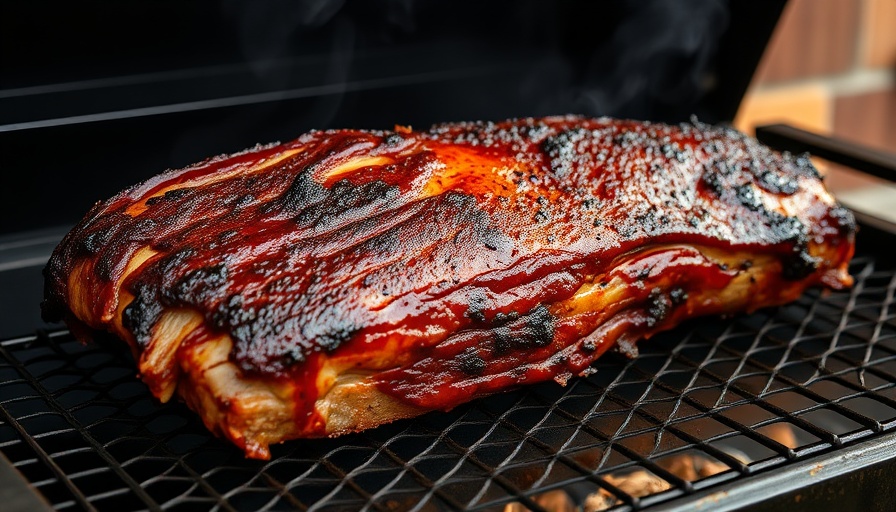
How to Achieve the Perfect Texas Style Brisket Every Time
If there's one dish that epitomizes Texas BBQ culture, it's the brisket. Known for its smoky flavor, tender texture, and deep, rich bark, perfecting Texas style brisket requires patience, technique, and a touch of artistry. In this guide, I will break down the entire process from trimming and seasoning to smoking and resting this delicious cut of meat, ensuring you have all the tools you need to impress at your next cookout.
In 'Perfecting Texas Style Brisket - a complete guide', the discussion dives into the traditional and modern ways to craft the perfect brisket, exploring key insights that sparked deeper analysis on our end.
The Essential Trimming Process
Properly trimming a brisket is critical for achieving the perfect cook and flavor. Start with a good brisket slicer to make your trimming more efficient. Begin by removing the entire decal, commonly known to BBQ enthusiasts as the ‘flex’ or ‘sheet’, which prevents the brisket from cooking evenly. Then, flip the brisket and create a ‘mohawk’ by removing excess fat. The goal here is to ensure that the leanest parts are adequately protected while allowing the fat to enhance flavor during cooking. The right trim not only improves the look of every slice but also ensures that nothing goes to waste; trimmings can be used to boost the flavor of your burgers or even be turned into sausage through innovative recipes.
Secrets of Flavor: Seasoning and Marinating
In the world of BBQ, seasoning is a pivotal moment in the brisket preparation. A traditional Texas rub typically includes salt, pepper, garlic, and a hint of paprika—which not only provides flavor but also adds color. Slather the brisket with yellow mustard before applying the rub; this not only helps your seasoning to adhere but also enhances that glorious bark during the smoking process. If you're willing to plan ahead, refrigerating your seasoned brisket overnight allows for deeper flavor penetration, ensuring a richer and juicier bite when served.
Understanding the Smoking Technique
For many BBQ enthusiasts, it’s the smoking process that truly brings the brisket to life. Using a large smoker is ideal for even cooking, but even smaller offsets or pellet grills can produce fantastic results. When starting your fire, create a solid coal bed and add logs of post oak, which is a quintessential wood type for that authentic Texas flavor. It’s important to monitor your pit temperature diligently, aiming to keep it around 250°F. Remember, the first few hours are crucial for smoke absorption, so consider placing your brisket inside while the fire is still coming up to temp.
Key Considerations for Wrapping
As your brisket approaches that perfect temperature for wrapping (generally around 180°F), it’s important to understand your options. The use of butcher paper allows for a better bark retention as compared to aluminum foil, which can trap moisture and soften the crust. Whichever option you choose, ensure that the wrap is snug; you want to keep the brisket as flavorful as possible during the final stages of cooking.
Mastering the Cooking Process
As the brisket cooks, maintaining vigilance is essential. Rely on both visual cues and physical checks (the grip test) to determine tenderness. The perfect brisket reaches an internal temperature of approximately 203°F, but texture matters even more. If you’re cooking for an event, consider timing; resting your brisket at a temperature conducive to allowing the flavors to meld can enhance the experience. A warmer at around 145°F can help maintain that fresh-out-of-the-smoker quality.
How to Slice and Serve the Brisket
Finally, it’s time to present the masterpiece. When slicing brisket, always cut against the grain for maximum tenderness. Begin with the point, moving to the flat and ensuring each slice showcases that beautiful pink smoke ring. This not only enhances presentation but also locks in flavors, providing a melt-in-your-mouth experience that will have your guests raving. Remember, in barbecue culture, the enjoyment comes from both the food and the communal experience of sharing it.
Common Pitfalls and How to Avoid Them
Even experienced cooks can make mistakes. Some common issues include under-seasoning, which leads to bland meat, or overcooking, resulting in dry brisket. Also, keep in mind the cutting technique; slicing improperly could lead to a less enjoyable meal. Always invest time in learning the crafting of each stage of cooking, and don’t hesitate to experiment and adjust your techniques. The beauty of BBQ lies in learning what works for your style.
Conclusion: Your Journey to BBQ Mastery
Perfecting Texas style brisket isn’t just about the end result—it’s about the entire journey. Each cook brings a new opportunity to refine your technique, experiment with flavors, and celebrate the eating experience with family and friends. As you explore the traditional methods and innovative approaches outlined in this guide, remember that sharing your BBQ expertise with others can create new palm-tingling memories.
If you're eager to unlock even more BBQ secrets, be sure to dive into the resources available on our channel and continue your journey to becoming a grill master. Barbecue is a craft that rewards patience and creativity, so go ahead and fire up those smokers!
 Add Row
Add Row  Add
Add 



Write A Comment